Abstract
The Altai Mountains of Kazakhstan form a critical part of the Altai-Sayan Ecoregion, one of Central Asia’s most important centers of plant endemism and biodiversity. However, this fragile mountain ecosystem is increasingly threatened by climate change, unsustainable land use, and habitat degradation. This study provides the first comprehensive checklist of rare, endemic, and endangered vascular plant species of Kazakhstan’s Altai, integrating herbarium data and spatial analyses to support regional conservation and sustainability goals. A total of 65,540 herbarium specimens from eight major collections were reviewed, and species identifications were verified using national and international databases. In total, 230 rare and endangered species were recorded, including 73 strict endemics. Species were assessed using IUCN Red List categories, and their distributions analyzed with GIS and hierarchical clustering tools. The results revealed a high concentration of threatened species in the Ivanovskiy, Narym, and Azutau ridges. Notably, 127 species were assessed for rarity status for the first time, with families such as Poaceae and Orchidaceae disproportionately represented. The study highlights substantial gaps in current conservation frameworks, as many species remain in the “Data Deficient” category, and some highly threatened taxa occur outside protected areas. These findings provide essential baseline data to inform the expansion of protected zones, guide national Red Book updates, and support targeted ex situ conservation. By prioritizing biodiversity-rich areas and incorporating plant rarity data into spatial planning, this research contributes directly to long-term sustainability and ecosystem resilience strategies in Kazakhstan’s mountainous regions.
1. Introduction
The study of rare and endangered plant species represents one of the most effective strategies for preserving the biodiversity of local floras [1]. Globally, biodiversity is facing unprecedented threats, with an estimated one million species currently at risk of extinction [2]. This alarming trend is mirrored at regional scales, where the increasing number of rare and threatened species has become a persistent and critical concern in recent years [3,4].
Floristic regions characterized by mountainous terrain, such as the Kazakhstan Altai, are particularly vulnerable and experiencing significant adverse impacts due to climate change. The Kazakhstan Altai stands out as one of the richest floristic regions in Kazakhstan, ranking among the leaders in terms of both biological diversity and the number of endemic species [5,6,7,8]. For instance, it is estimated to harbor over 2465 vascular plant species [9], with approximately 150–200 considered endemic to the broader Altai-Sayan mountain system [10]. The region’s unique geographical position, complex geological structure, varied topography, as well as its diverse soil–climatic and hydrological conditions, collectively contribute to the formation of distinct orographic complexes: the Western, Southern, and Kalba Altai [11] (Figure 1). These diverse habitats foster a high level of species richness and endemism.
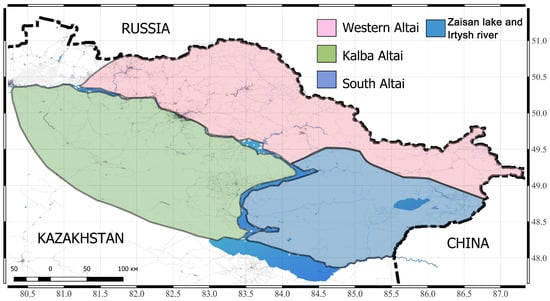
Figure 1.
Geographical division of Kazakhstan’s Altai mountain system into its constituent orographic complexes.
Ecologically, the Kazakhstan Altai is highly variable, encompassing a remarkable range of landscapes from semi-deserts and steppes in the foothills to high-altitude alpine meadows and tundras. The region’s climatic conditions are primarily determined by its central location within the Eurasian continent, equidistant from major oceans, its proximity to the deserts of Mongolia and Central Asia, and its position within the continental–oceanic system of air mass circulation. This continental climate, characterized by harsh winters and warm summers, is increasingly impacted by global warming, leading to shifts in vegetation zones, altered phenology, and increased pressure on sensitive species.
Research on the floristic characteristics of Kazakhstan’s Altai is of paramount importance for understanding and conserving its unique botanical heritage [12,13]. Over the past decades, significant efforts have been made, including the compilation of floristic checklists for specific areas and districts [14,15,16,17], assessments of industrial reserves of useful plant species in Kazakhstan [18,19,20,21,22], and numerous floristic discoveries for the flora of Kazakhstan and the Kazakhstan Altai [23,24,25,26,27]. Particular emphasis has been placed on studying rare and endangered plants, especially narrowly endemic species, which are often highly sensitive to environmental changes [28,29,30]. In recent years, a substantial number of studies on rare species have been conducted in adjacent territories, such as the Russian Altai and Mongolia [31,32,33,34,35,36], and the distribution of individual rare species within the Kazakhstan Altai has also been examined [37,38,39]. However, despite these valuable contributions, current comprehensive data on the conservation status of rare species across the entire Kazakhstan Altai region remain limited and fragmented.
The region harbors 48 endangered species listed in the Red Book of Kazakhstan, underscoring its ecological significance [40]. These include, but are not limited to, Huperzia selago (L.) Bernh. ex Schrank et C. Mart., Tulipa heteropetala Ledeb., Cypripedium macranthos Sw., Dactylorhiza fuchsii (Druce) Soó, Orchis militaris L., Iris ludwigii Maxim., Iris tigridia Bunge ex Ledeb., Hemerocallis minor Mill., Allium microdictyon Prokh., Stipa austroaltaica Kotukhov, Adonis vernalis L., Paeonia anomala L., Rhodiola rosea L., Drosera rotundifolia L., Rheum compactum L., Vaccinium microcarpum (Turcz. ex Rupr.) Schmalh., Tanacetum kelleri (Krylov & Plotn.) Takht, and others [40]. All of the 48 endangered species from Kazakhstan’s Altai were included in the current study.
The presence of a substantial number of endemic species further highlights the uniqueness and ecological vulnerability of the region’s biodiversity, representing irreplaceable components of its natural heritage. Notable endemic taxa include Erythronium sibiricum (Fisch. & C.A. Mey.) Krylov, Gagea altaica Schischk. et Sumnev., Gagea azutavica Kotukhov, Allium ivasczenkoae Kotukhov, Elymus karakabinicus Kotukhov, Stipa austroaltaica Kotukhov, Delphinium austroaltaicum A.L. Ebel, Sibiraea laevigata (L.) Maxim., Erysimum kotuchovii D.A. German (E. quadrangulum Desf.), Rhododendron dauricum L., and Artemisia kotuchovii Kupr [5].
The remarkable plant diversity of Kazakhstan’s Altai Mountains is under mounting pressure from a complex interplay of environmental and anthropogenic threats. Climate change is accelerating habitat shifts, forcing vegetation zones to higher elevations and drastically reducing the range of cold-adapted alpine and subalpine species [41]. Altered precipitation regimes—marked by intensified droughts and erratic rainfall—further hinder plant growth and regeneration [42]. Increasingly frequent wildfires and disrupted snowmelt patterns exacerbate ecological stress, impacting water availability and destabilizing fragile high-altitude ecosystems. Simultaneously, human-driven pressures such as habitat fragmentation from expanding agriculture, infrastructure projects (e.g., mining, road construction), and unsustainable logging severely degrade critical plant habitats [43]. Overharvesting of medicinal and ornamental wild plants, along with unmanaged livestock grazing, leads to soil erosion and shifts in community composition that disadvantage sensitive native species. Moreover, rising tourism and recreation cause trampling and localized disturbances in ecologically vulnerable zones [43], while invasive alien species continue to spread, competing with native flora and altering ecosystem dynamics [44]. Although natural hazards like landslides are less frequent, their ecological impacts may intensify under climate-induced environmental instability.
These interlinked stressors threaten the ecological resilience and long-term sustainability of the region’s plant communities, many of which include rare, endangered, and endemic taxa. Declining plant diversity compromises ecosystem services critical to sustainable land use, climate regulation, and local livelihoods. In light of these challenges, the present study aims to compile a current and comprehensive checklist of rare and endangered plant species in Kazakhstan’s part of the Altai Mountains, assess their conservation status, categorize them by rarity, and propose integrated, sustainability-oriented measures for their conservation and management.
2. Materials and Methods
2.1. Data Sources and Collection
To compile a checklist of rare and endangered plant species of Kazakhstan’s Altai, we analyzed herbarium specimens of vascular plants collected over several decades across various mountain ranges of the region. These specimens were obtained from the collections of eight organizations: the Altai Botanical Garden (ABG, Ridder, Kazakhstan), the herbarium of Altai State University (ALTB, Barnaul, Russia), the herbarium of the Institute of Botany and Phytointroduction (AA, Almaty, Kazakhstan), the herbarium of Tomsk State University (TK, Tomsk, Russia), the herbarium of Novosibirsk State University (NS, Novosibirsk, Russia), the Central Siberian Botanical Garden herbarium (NSK, Novosibirsk, Russia), the herbarium of the Komarov Botanical Institute of the Russian Academy of Sciences (LE, St. Petersburg, Russia), and the herbarium of the Main Botanical Garden, Russian Academy of Sciences (MW, Moscow, Russia) [45].
In total, 65,540 herbarium sheets were reviewed, including 10,024 specimens collected by the authors during targeted field expeditions between 2023 and 2025. Species identifications were verified, and distributional data were checked against national and international databases. A number of species were originally described from the territory of Kazakhstan’s Altai and represent narrow endemics.
2.2. Criteria for Assessment and Geographic Framework
The study was based on previously published works concerning floristic novelties for the flora of Kazakhstan and taxonomic discoveries new to science [46,47,48,49,50,51,52,53]. The criteria for inclusion in the checklist included the following: naturally restricted distribution ranges, declining population trends observed through long-term monitoring, levels of anthropogenic pressure, and the extent of habitat transformation affecting rare plant species. The degree of rarity within the study area was assessed following the IUCN Red List categories [54]: CR (critically endangered), EN (endangered), VU (vulnerable), NT (near threatened), LC (least concern), DD (data deficient), and NE (not evaluated). For a comprehensive assessment of conservation status, species were compared across several conservation reference frameworks, including the Red Book of Kazakhstan [40], the IUCN Red List [54], and regional Red Books of neighboring territories: the Red Book of Altai Krai (Russia) [55], the Red Book of the Altai Republic (Russia) [56], and the Red List of China [57]. For geographic zoning within the Kazakhstan Altai, the following subdivision of mountain ranges was used: Southern Altai includes Chindogatui Mountains, Kurchum ridge, Narym ridge, Sarymsakty ridge, South-Altai Tarbagatai ridge, Bukhtarma Mountains, Azutau ridge, South Altai ridge, and the Karakaba Depression; Western Altai includes Ivanovskiy ridge, Lineyskiy ridge, Uba ridge, Ulba ridge, Eastern Listvyaga ridge, Western Listvyaga ridge, Holzun ridge, and Koksa ridge; and Kalba Altai includes Eastern Kalba ridge.
2.3. Taxonomy, Classification, and Analytical Tools
Species nomenclature follows the globally recognized system Plants of the World Online (POWO) [58]. The nomenclature of the family Poaceae Turcz. was adopted according to the taxonomic revisions by Y. A. Kotukhov [59], while the taxonomy of the genus Tulipa L. follows the latest phylogenetic and morphological studies [60,61]. Plant families in the checklist are arranged according to the evolutionary classification system APG IV [62]. Distribution maps were generated using QGIS version 3.26.1 [63], and dendrograms were constructed using the R version 4.5.0 [64]. Plant species were assigned to ecological groups based on their water and soil preferences, following the classification approach proposed by Black (1971) [65], which considers physiological and ecological traits related to photosynthetic capacity and habitat adaptation.
3. Results
Based on the analysis of herbarium collections and results from field expeditions, 230 rare and endangered species were identified out of the 2465 species recorded in the flora of Kazakhstan’s Altai (Table S1). Among these, 24 species are officially listed in the Red Data Book of Kazakhstan, 64 species are included in the IUCN Red List, and 65 species have protected status in adjacent regions such as Altai Krai (Russia), the Altai Republic (Russia), and China. For 127 species, rarity status is reported here for the first time.
The checklist of rare species in the Kazakhstan Altai comprises the following IUCN categories: CR (critically endangered)—10 species; EN (endangered)—40 species; VU (vulnerable)—62 species; NT (near threatened)—26 species; LC (least concern)—18 species; DD (data deficient)—52 species; and NE (not evaluated)—22 species (Figure 2). Notably, a high proportion of endemic species fall into the EN (14 species) and VU (15 species) categories. Particular concern arises for species categorized as DD and NE, due to insufficient data or lack of evaluation. More than half of these are endemics: 30 species (57%) in the DD category and 12 species (54%) in NE.
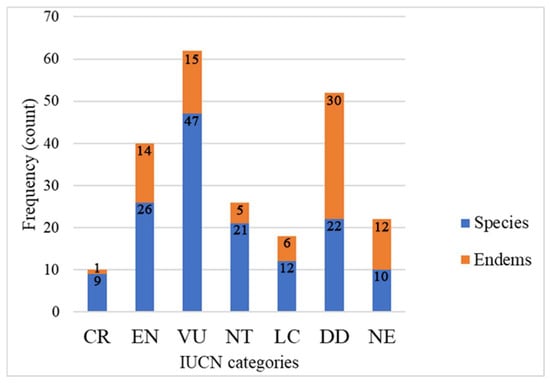
Figure 2.
Ranking of rare plant species of Kazakhstan’s Altai by rarity categories and by the presence of endemic species among them. CR—critically endangered, EN—endangered, VU—vulnerable, NT—near threatened, LC—least concern, DD—data deficient, NE—not evaluated.
Analysis of the composition of the top 10 families represented in the checklist revealed that the majority of species belong to categories VU (62 species) and DD (52 species) (Figure 3, Table 1). Within families, species of Poaceae predominantly fall under DD (37%) and NE (18%). In contrast, most species of Orchidaceae are categorized as VU (51%) and EN (19%), with minimal representation in other categories. The relatively low number of CR species (10 species) is a positive indicator for the conservation outlook of the region’s biodiversity.
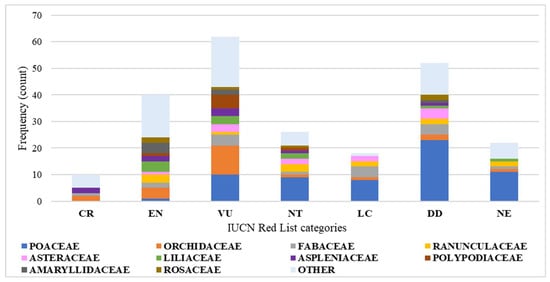
Figure 3.
Distribution of plant species belonging to 10 dominant families across different IUCN Red List threat categories. CR—critically endangered, EN—endangered, VU—vulnerable, NT—near threatened, LC—least concern, DD—data deficient, NE—not evaluated.

Table 1.
Structure of the top 10 families by rarity categories.
Most species identified as rare in the Kazakhstan Altai are also rare throughout Kazakhstan due to their extremely narrow ecological specialization. Distribution analysis (Figure 4) shows that these species are mainly confined to the Kazakhstan Altai, Tarbagatai (36 species), Dzungarian Alatau (32 species), and Zailiysky Alatau (20 species), reinforcing the urgency of their conservation.
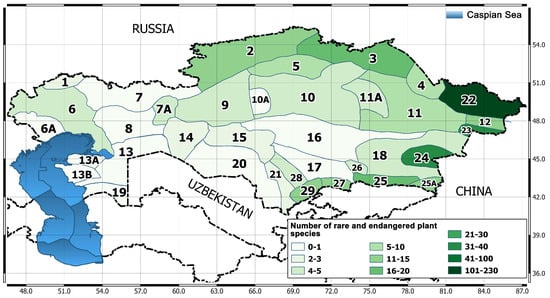
Figure 4.
Distribution patterns of rare and endangered plants of Kazakhstan’s Altai in other Kazakhstan floristic regions. 1—Spurs of the General Syrt; 2—Tobol-Ishim; 3—Irtysh; 4—Semipalatinsk pinery; 5—Kokchetav; 6—Caspian; 6A—Bukeyev; 7—Aktobe; 7A—Mugodzhary; 8—Emba; 9—Turgai; 10—Western upland; 10A—Ulutau; 11—East upland; 11A—Karkaraly; 12—Zaysan; 13—Northern Ust-Urt; 13A—Buzachi; 13B—Mangyshlak; 14—Aral; 15—Kzyl Orda; 16—Betpak-Dala; 17—Muyunkum; 18—Balkhash-Alakol; 19—South Ust-Urt; 20—Kzyl-Kum; 21—Turkestan; 22—Altai; 23—Tarbagatai; 24—Dzungarian Alatau; 25—Ile Kungei Alatau; 25A—Ketmen Terskey Alatau; 26—Chu-Ili mountains; 27—Kyrgyz Alatau; 28—Karatau; 29—Western Tien Shan.
Analysis of species’ overall range types revealed 17 distinct distribution types (Figure 5A), most of which are associated with various regions of Siberia and Asia. The dominant range types among the checklist species include the Holarctic (30 species), Eurasian (31 species), and Altai-specific (39 species). Fewer species fall under cosmopolitan (3 species) and Siberian Altai (2 species) distributions.

Figure 5.
Main types of habitats (A) and the main ecological groups (B) of rare plant species in Kazakhstan’s Altai.
Ecological affiliation analysis based on water and soil preferences identified eight main ecological groups (Figure 5B). Most species belong to mesophytic (160 species) and xerophytic (111 species) groups, consistent with the general flora composition of the Kazakhstan Altai. Less represented are species classified as hygrophytes (2 species), saprophytes (3 species), and halophytes (5 species).
Spatial distribution analysis revealed high variability in the density of rare and endangered species across mountain ranges (Figure 6A). Their distribution is largely uneven, with the greatest concentrations found in regions experiencing significant industrial or agricultural impact. The highest numbers of rare species were recorded on the Ivanovskiy ridge (80 species) and the Narymskiy ridge (70 species), explained by the high biodiversity and anthropogenic pressure in these areas. Conversely, the lowest numbers were observed on the Western Listvyaga (10 species), Eastern Listvyaga (1 species), and Karakaba depression (12 species), which are geographically remote and less affected by human activities.
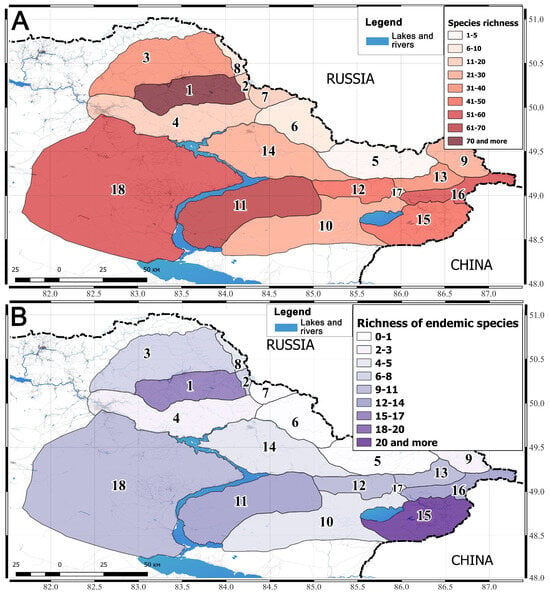
Figure 6.
Amount of rare endangered (A) and rare endemic (B) plant species in the mountain ranges of Kazakhstan’s Altai. 1—Ivanovskiy ridge, 2—Lineiskiy ridge, 3—Uba ridge, 4—Ulba ridge, 5—East Listvyaga ridge, 6—Western Listvyaga ridge, 7—Holzun ridge, 8—Koksa ridge, 9—Chindogatui Mountains, 10—Kurchum ridge, 11—Narym ridge, 12—Sarymsacty ridge, 13—South-Altai Tarbagatai ridge, 14—Bukhtarma Mountains, 15—Azutau ridge, 16—South Altai ridge, 17—Karakaba Depression, 18—East Kalba ridge.
A total of 73 species (31.7%) are endemics of the Altai or specifically the Kazakhstan Altai (Figure 6B). The high number of endemic species among the rare and endangered flora reflects an ongoing process of speciation in this territory. However, endemic species are unevenly distributed. Two main centers of endemism were identified: the western part of Western Altai and the eastern part of Southern Altai. The largest number of endemic species were recorded on the Azutau ridge (22 species) and the Ivanovskiy ridge (15 species) (Figure 6B). By contrast, the northeastern ranges of the Kazakhstan Altai are characterized by a low number of endemics: Chindogatui Mountains (3), Western Listvyaga (1), Holzun ridge (0), and Eastern Listvyaga (0). This likely reflects their greater geographic and floristic affinity with adjacent Siberian mountain ranges, which are comparatively poor in endemic taxa.
Dendrogram analysis of rare species distribution across the mountain ranges of the Kazakhstan Altai revealed clear clustering based on geographic proximity. Despite spatial separation, the ridges of Western and Southern Altai share a high number of species (Figure 7A). The Ivanovskiy and Narym ridges, which harbor the highest number of rare species, form the distinct Cluster I. The ranges of Southern and Kalba Altai are grouped into broader Clusters II and III. Only the Uba ridge from Western Altai is included in these clusters, while the rest form the separate Cluster IV. Cluster analysis based on the presence of endemic species (Figure 7B) clearly separates the ridges of Southern and Western Altai. The former are concentrated in Clusters I and III, whereas the latter are grouped in Cluster II. This dendrogram confirms the narrow ecological and geographical specialization of endemic species in Kazakhstan’s Altai.
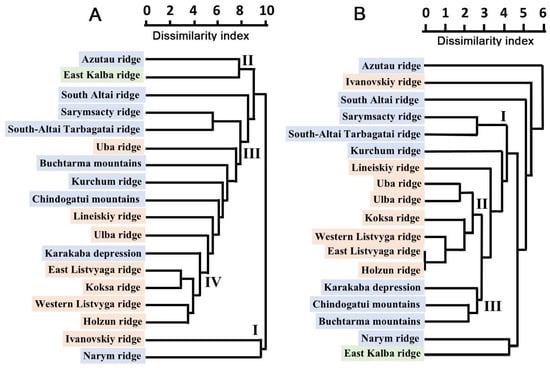
Figure 7.
Dendrograms showing the floristic similarity among mountain ranges of the Kazakhstan Altai, generated by cluster analysis. Clusters based on the occurrence of rare and endangered plant species (A) and clusters based on the occurrence of endemic plant species (B). Ranges of the Southern Altai are indicated by blue shading, Western Altai by peach shading, and Kalba Altai by green shading.
The majority of rare species listed in the checklist occur within protected areas or have been introduced into the Altai Botanical Garden (55 species). Most are preserved in the Katon-Karagai National Park (116 species), as well as the Markakol (32 species) and West Altai (39 species) nature reserves (Figure 8A). However, 63 rare species grow outside of protected areas and remain vulnerable (Figure 8B).
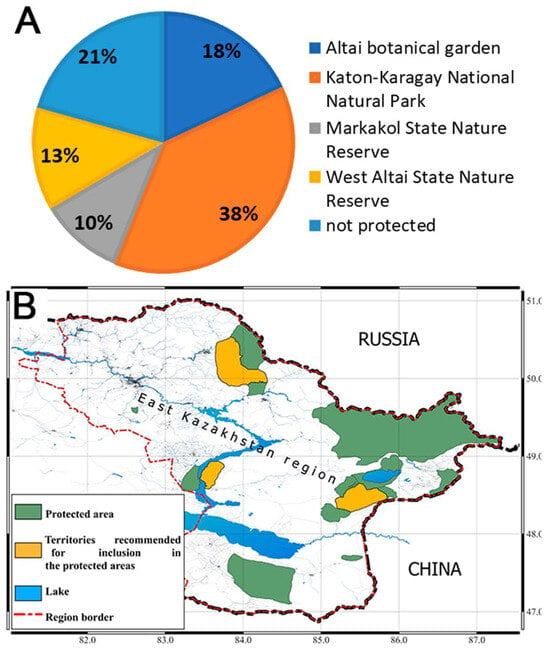
Figure 8.
Distribution of rare species listed in the checklist among major specially protected natural areas (A) and their territories (B) in Kazakhstan’s Altai.
4. Discussion
The current study presents the first comprehensive and up-to-date checklist of endemic and endangered vascular plant species in the Kazakhstan sector of the Altai Mountains, identifying 230 taxa of conservation concern (Table S1). Notably, 127 of these species were assessed for rarity for the first time, highlighting the importance of field-based botanical research in underexplored mountain regions.
Our findings demonstrate that rare and endemic species are disproportionately concentrated in specific taxonomic groups. The most represented families among rare species were Poaceae, Orchidaceae, and Fabaceae (Figure 3, Table 1), consistent with trends observed in other mountainous regions of Central Asia and Siberia [5,32]. The prevalence of Orchidaceae among threatened species, particularly in the EN and VU categories, aligns with the global pattern of orchids being sensitive to microhabitat disturbance and exhibiting complex ecological dependencies [66]. The endemism rate observed in our study for the Kazakhstan Altai (31.7%) is relatively high and comparable to other major mountain biodiversity hotspots in the region. The pronounced endemic richness is largely concentrated on the Azutau and Ivanovskiy ridges (Figure 6B). For comparison, the Caucasus region has an endemism rate of approximately 25–30%, depending on the taxonomic scope and elevation range considered [67]. In the Tien Shan, vascular plant endemism rates range from 20% to over 30% in some subregions [68]. Thus, the Kazakhstan Altai exhibits a similar or slightly higher level of endemism, highlighting its significance for regional and global plant biodiversity conservation.
Spatial analysis of rare and endemic species indicates substantial variation in species richness among mountain ranges. The Ivanovskiy and Narym ridges support the highest number of rare species (Figure 6A), likely due to their large area, ecological heterogeneity, and exposure to potential anthropogenic threats such as grazing and fires. In contrast, ranges such as Holzun and Eastern Listvyaga show lower diversity, possibly due to their floristic affinities with the less endemic-rich Siberian Highlands. This pattern is supported by our cluster analysis, which revealed floristic similarity among geographically and ecologically connected ranges. The clear separation of floristic clusters between Western and Southern Altai (Figure 7) further supports the hypothesis of independent evolutionary and ecological trajectories within these subregions. Endemic species show narrow ecological tolerances and often occupy specific altitudinal belts, reinforcing the need for localized conservation strategies.
Our IUCN-based rarity ranking reveals a high proportion of species in the VU (62 species) and DD (52 species) categories (Figure 2). The overrepresentation of DD species, particularly among Poaceae, reflects significant knowledge gaps in taxonomy, distribution, and population trends. This issue is not unique to the Altai: the global flora is estimated to contain over 20% of species with insufficient data for conservation assessment [54]. The region is exceptionally rich in Poaceae. The high representation of this family reflects the area’s ecological diversity and its role as a center of diversification for cereals and various interspecific hybrids. The comparatively low number of CR species (10 species) may be cautiously interpreted as a positive indicator; however, this may also reflect under-reporting or insufficient monitoring. Endemics are especially vulnerable, with more than half of the species in the DD and NE categories being endemic—a red flag for future extinction risk under climate change and habitat loss. Despite the presence of several protected areas (e.g., Katon-Karagai National Park, Markakol and West Altai reserves), 63 rare species fall outside existing conservation zones, highlighting major gaps in Kazakhstan’s protected area network (Figure 8). This underscores the urgent need to expand conservation efforts in the Ivanovskiy, Narym, and Azutau ridges, which serve as biodiversity hotspots and centers of endemism.
The high levels of plant endemism and rarity in the Kazakhstan Altai are primarily shaped by the region’s complex orography, glacial history, and long-term climatic stability. The Altai Mountains are widely recognized as a Pleistocene refugium, where cold-adapted species persisted during glaciations [6,39]. Post-glacial isolation and microhabitat specialization likely promoted speciation, as reflected in the large number of narrow endemics documented here. Anthropogenic threats remain a pressing concern. Industrial development, mining, uncontrolled grazing, and land conversion are rapidly altering key habitats. Many species are vulnerable to edge effects, fragmentation, and overharvesting, particularly those with medicinal or ornamental value, such as Rhodiola rosea [37] and Allium microdictyon [7]. Climate change compounds these pressures by shifting vegetation belts, reducing snow cover, and increasing fire frequency.
Ecological affiliation analysis based on water and soil preferences revealed eight main ecological groups (Figure 5B), with mesophytes (160 species) and xerophytes (111 species) being the most dominant. This pattern is consistent with the overall floristic composition of the Kazakhstan Altai, where mesophytic species prevail due to the region’s temperate and humid climate. As part of the southern Siberian floristic province, the Kazakhstan Altai experiences significantly more precipitation and moderate temperatures compared to arid Central Asian regions, supporting a predominance of moisture-loving species across various habitats. In contrast, hygrophytes (2 species), saprophytes (3 species), and halophytes (5 species) are sparsely represented, reflecting the limited availability of habitats suited to their specific ecological requirements.
The findings of this study have direct implications for biodiversity conservation planning in Kazakhstan and the broader Altai-Sayan Ecoregion. We recommend expanding the network of protected areas and prioritizing legal protection and surveillance in biodiversity-rich zones such as the Ivanovskiy, Narym, and Azutau ridges. These subregions not only harbor high concentrations of rare and endemic taxa but also represent ecological gradients influenced by climatic variables such as precipitation, temperature, and altitudinal range—factors that play a critical role in species distribution and vulnerability. To support national conservation efforts, we emphasize the importance of integrating our data into future revisions of Kazakhstan’s Red Data Book. The 127 species with newly assigned rarity statuses should be formally evaluated for inclusion. Additionally, establishing long-term ecological monitoring programs is essential to track population dynamics and emerging threats, particularly under changing climate conditions.
More specific protection strategies are also warranted. In situ conservation efforts should include habitat zoning, strict enforcement against industrial encroachment, and targeted habitat restoration in degraded areas. For species categorized as CR and EN that fall outside existing reserves, urgent ex situ measures such as seed banking, cultivation in botanical gardens, and micro-reserve establishment are recommended. While this study is limited to the Kazakhstani portion of the Altai Mountains, the patterns observed may hold relevance for adjacent regions, including the Chinese and Russian sectors of the Altai. Future transboundary comparative studies will be essential to fully understand regional floristic trends and to coordinate international conservation strategies within the broader Altai-Sayan Ecoregion.
The presented checklist serves as a foundational dataset for informing national biodiversity strategies, guiding spatial prioritization of conservation actions, and supporting educational and public awareness initiatives on the importance of preserving unique mountain flora.
While this study represents the most complete checklist to date for the region, several limitations must be acknowledged. Some remote or inaccessible ranges remain under-sampled, potentially underestimating species diversity. Taxonomic uncertainties persist, particularly among cryptic species complexes in Poaceae and Asteraceae. Additionally, the use of herbarium data, while invaluable, may not reflect current population statuses due to time lags in collection. Future studies should integrate molecular phylogenetics to clarify species boundaries, model species distributions under future climate scenarios, and investigate the reproductive biology and genetic diversity of narrow endemics. Cross-border collaborations with Russian, Mongolian, and Chinese botanists would also enhance regional-scale conservation planning.
5. Conclusions
This study provides the first comprehensive checklist of rare, endangered, and endemic vascular plant species of Kazakhstan’s Altai Mountains, identifying 230 species of conservation concern, including 127 assessed for rarity for the first time. The analysis revealed a high proportion of species in the IUCN categories VU and DD, with notable representation of Poaceae, Orchidaceae, and Fabaceae. Endemism is pronounced, with 73 species confined to the Altai region, especially concentrated on the Azutau and Ivanovskiy ridges. These findings affirm the hypothesis that the Kazakhstan Altai serves as both a biodiversity hotspot and a center of active speciation shaped by complex topography, ecological gradients, and historical refugial dynamics. The clustering of rare and endemic taxa in ecologically heterogeneous and anthropogenically pressured areas emphasizes the urgent need for targeted protection. Although existing protected areas harbor many rare species, 63 taxa remain unprotected, pointing to major gaps in Kazakhstan’s conservation network. Therefore, the Kazakhstan Altai is a vital refuge for rare and endemic plant diversity in Central Asia. The checklist presented here lays a foundation for national conservation planning and highlights the need for urgent, data-informed, and spatially targeted protection strategies. Safeguarding this unique flora is not only a national priority, but also a global responsibility.
Supplementary Materials
The following supporting information can be downloaded at https://www.mdpi.com/article/10.3390/su17167283/s1, Table S1: rarity and conservation status of endemic plant species in Kazakhstan’s Altai.
Author Contributions
Conceptualization, A.A.S. and Y.A.K.; methodology, Y.A.K.; software, A.N.D.; validation, A.N.D. and M.A.; formal analysis, A.A.S., A.N.D., and M.A.; investigation, Y.A.K.; resources, A.A.S.; data curation, A.A.S.; writing—original draft preparation, A.A.S., Y.A.K., A.N.D., and M.A.; writing—review and editing, A.A.S.; visualization, M.A.; supervision, A.N.D.; project administration, A.A.S.; funding acquisition, A.A.S. All authors have read and agreed to the published version of the manuscript.
Funding
This research was funded by the Science Committee of the Ministry of Science and Higher Education of the Republic of Kazakhstan, grant AP19674778 “Study of distribution and current state of rare species (genus Allium) in Eastern Kazakhstan and introduction in Altai Botanical Garden” for 2023–2025.
Institutional Review Board Statement
Not applicable.
Informed Consent Statement
Not applicable.
Data Availability Statement
The original contributions presented in this study are included in the article/Supplementary Material. Further inquiries can be directed to the corresponding author.
Conflicts of Interest
Authors Aidar A. Sumbembayev, Yuriy A. Kotukhov and Alevtina N. Danilova are from Altai Botanical Garden. The remaining authors declare that the research was conducted in the absence of any commercial or financial relationships that could be construed as a potential conflict of interest.
Abbreviations
The following abbreviations are used in this manuscript:
| AA | Herbarium of the Institute of Botany and Phytointroduction |
| ABG | Herbarium of Altai Botanical Garden |
| ALTB | Herbarium of Altai State University |
| CR | Critically Endangered plant species |
| DD | Data Deficient |
| EN | Endangered plant species |
| IUCN | International Union for Conservation of Nature and Natural Resources |
| LC | Least Concern plant species |
| LE | Herbarium of Komarov Botanical Institute of the Russian Academy of Sciences |
| MW | Herbarium of the Main Botanical Garden, Russian Academy of Sciences |
| NE | Not Evaluated |
| NS | Herbarium of Novosibirsk State University |
| NSK | Central Siberian Botanical Garden herbarium |
| NT | Near Threatened plant species |
| TK | Herbarium of Tomsk State University |
| VU | Vulnerable plant species |
References
- Avhad, A.; Patil, N.; Zunjarrao, R. Overview of in vitro strategies to conserve rare and endangered plant species in India. Int. J. Sci. Res. Arch. 2023, 9, 650–669. [Google Scholar] [CrossRef]
- Intergovernmental Science-Policy Platform on Biodiversity and Ecosystem Services (IPBES). Global Assessment Report on Biodiversity and Ecosystem Services. In IPBES Secretariat; Brondízio, E.S., Settele, J., Díaz, S., Ngo, H.T., Eds.; IPBES: Bonn, Germany, 2019. [Google Scholar]
- White, H.J.; McKeon, C.M.; Pakeman, R.J.; Buckley, Y.M. The contribution of geographically common and rare species to the spatial distribution of biodiversity. Glob. Ecol. Biogeogr. 2023, 32, 1730–1747. [Google Scholar] [CrossRef]
- Wood, C.M.; Champion, J.; Brown, C.; Brommelsiek, W.; Laredo, I.; Rogers, R.; Chaopricha, P. Challenges and opportunities for bioacoustics in the study of rare species in remote environments. Conserv. Sci. Pract. 2023, 5, e12941. [Google Scholar] [CrossRef]
- Kubentayev, S.A.; Alibekov, D.T.; Perezhogin, Y.V.; Lazkov, G.A.; Kupriyanov, A.N.; Ebel, A.L.; Izbastina, K.S.; Borodulina, O.V.; Kubentayeva, B.B. Revised checklist of endemic vascular plants of Kazakhstan. PhytoKeys 2024, 238, 241. [Google Scholar] [CrossRef]
- Dimeyeva, L.; Permitina, V.; Kurmantayeva, A.; Imanalinova, A.; Osmonali, B.; Kozybayeva, F.; Beiseyeva, G.; Ussen, K.; Iskakov, R.; Oyuntsetseg, B.; et al. Habitats, Plant Diversity, and Molecular Phylogeny of Endemic Relic Species Incarvillea semiretschenskia (Bignoniaceae). Plants 2024, 13, 3299. [Google Scholar] [CrossRef]
- Abdildanov, D.S.; Vesselova, P.V.; Kudabayeva, G.M.; Osmonali, B.B.; Skaptsov, M.V.; Friesen, N. Endemic of Kazakhstan Allium lehmannianum Merckl. Ex Bunge and Its Position Within the Genus Allium. Plants 2025, 14, 1113. [Google Scholar] [CrossRef]
- Orazov, A.; Myrzagaliyeva, A.; Mukhitdinov, N.; Tustubayeva, S. Callus induction with 6-BAP and IBA as a way to preserve Prunus ledebouriana (Rosaceae), an endemic plant of Altai and Tarbagatai, East Kazakhstan. Biodiversitas 2022, 23, 6. [Google Scholar] [CrossRef]
- Kotukhov, Y.A. List of vascular plants of the Kazakhstan Altai. Bot. Stud. Sib. Kazakhstan 2005, 11, 11–83. [Google Scholar]
- Samdan, A.M.; Chimitov, D.G. Identification of genetic connections between the flora of the Alash plateau (the Republic of Tyva, Western Sayan) and the Altai-Sayan Mountain country. Proc. Mordov State Nat. Res. P. G. Smidovich 2024, 35, 14. [Google Scholar]
- Danilova, A.; Sumbembayev, A. The status of the Dactylorhiza incarnata populations in the Kalba Altai, Kazakhstan. Biodiversitas 2021, 22, 8. [Google Scholar] [CrossRef]
- Myrzagaliyeva, A.; Irsaliyev, S.; Tustubayeva, S.; Samarkhanov, T.; Orazov, A.; Alemseitova, Z. Natural Resources of Rhaponticum carthamoides in the Tarbagatai State National Nature Park. Diversity 2024, 16, 676. [Google Scholar] [CrossRef]
- Mamyrova, S.; Kupriyanov, A.; Ishmuratova, M.; Ivashchenko, A.; Myrzagaliyeva, A.; Orazov, A.; Kubentayev, S. The Current State of Populations of Rhaponticum altaicum (Asteraceae) in the Northern and Central Kazakhstan. Diversity 2025, 17, 206. [Google Scholar] [CrossRef]
- Bolbotov, G.A.; Kechaykin, A.A.; Shmakov, A.I. Flora of the Ushkurmynker ridge and adjacent territories (East Kazakhstan), Report 1. Acta Biol. Sib. 2022, 8, 185–198. [Google Scholar]
- Abitay, A.; Imanova, E.; Sumbembayev, A. Assessment of Plant Biodiversity and the Floristic Composition in the Black Irtysh River Valley (Kazakhstan). Diversity 2024, 16, 641. [Google Scholar] [CrossRef]
- Artemov, I.A. Floras of the Archatinskoe and Chernovinskoe Forestries of the Katon-Karagay State National Nature Park (the Republic of Kazakhstan). Acta Biol. Sib. 2020, 6, 107–138. [Google Scholar] [CrossRef]
- Alibekov, D.; Kubentayev, S.; Baasanmunkh, S.; Mukhtubayeva, S.; Tustubayeva, S.; Kubentayeva, B.; Suleimen, Y.; Choi, H.J. The first complete checklist of vascular plants in the Akmola region, Kazakhstan: A key to understanding biodiversity importance. J. Asia-Pac. Biodivers. in press. 2025. [Google Scholar] [CrossRef]
- Osmonali, B.; Tokbergenova, A.; Taukebayev, O.; Zulpykharov, K.; Salmurzauly, R.; Smanov, Z.; Ussen, S. Weed species in plant communities as indicators of degradation of vegetation cover and fertile soil layer in desert regions. Biodiversitas 2024, 25, 12. [Google Scholar] [CrossRef]
- Sitpayeva, G.T.; Kudabayeva, G.M.; Dimeyeva, L.A.; Gemejiyeva, N.G.; Vesselova, P.V. Crop wild relatives of Kazakhstani Tien Shan: Flora, vegetation, resources. Plant Divers. 2020, 42, 19–32. [Google Scholar] [CrossRef] [PubMed]
- Aimenova, Z.E.; Matchanov, A.D.; Esanov, R.S.; Sumbembayev, A.A.; Duissebayev, S.E.; Dzhumanov, S.D.; Smailov, B.M. Phytochemical profile of Eranthis longistipitata Regel from three study sites in the Kazakhstan part of the Western Tien Shan. Biodiversitas 2023, 24, 11. [Google Scholar] [CrossRef]
- Kusmangazinov, A.; Kurmanbayeva, M.S.; Zharkova, I.; Karabalayeva, D.; Kaparbay, R.; Kaiyrbekov, T. Comparison of anatomical characteristics and phytochemical components between two species of Hedysarum (Fabaceae). Online J. Biol. Sci. 2023, 23, 323–335. [Google Scholar] [CrossRef]
- Sagyndykova, M.; Imanbayeva, A.; Gassanova, G.; Ishmuratova, M. Current Status and Resources of Alhagi pseudalhagi (Fabaceae) in the Atyrau Region, Western Kazakhstan. Diversity 2024, 16, 219. [Google Scholar] [CrossRef]
- Friesen, N.; Vesselova, P.; Osmonaly, B.; Sitpayeva, G.; Luferov, A.; Shmakov, A. Allium toksanbaicum (Amaryllidaceae), a new species from Southeast Kazakhstan. Phytotaxa 2021, 494, 251–267. [Google Scholar] [CrossRef]
- Kubentayev, S.A.; Efimov, P.G.; Fateryga, A.V. Epipactis persica (Orchidaceae), a new taxon for the flora of Kazakhstan, Kyrgyzstan and China. Nat. Conserv. Res. 2024, 9, 115–117. [Google Scholar] [CrossRef]
- Osmonali, B.B.; Vesselova, P.V.; Kudabayeva, G.M.; Ussen, S.; Abdildanov, D.S.; Friesen, N. Contributions to the flora of Kazakhstan, genera Arthrophytum and Haloxylon. Plant Syst. Evol. 2025, 311, 6. [Google Scholar] [CrossRef]
- Sumbembayev, A.A.; Nowak, S.; Burzacka-Hinz, A.; Kosiróg-Ceynowa, A.; Szlachetko, D.L. New and noteworthy taxa of the genus Dactylorhiza Necker ex Nevski (Orchidaceae Juss.) in Kazakhstan flora and its response to global warming. Diversity 2023, 15, 369. [Google Scholar] [CrossRef]
- Kosachev, P.A.; Bolbotov, G.A. Two new species of Pedicularis (Orobanchaceae) from Eastern Kazakhstan. Turczaninowia 2025, 28, 162–174. (In Russian) [Google Scholar] [CrossRef]
- Tagimanova, D.; Raiser, O.; Danilova, A.; Turzhanova, A.; Khapilina, O. Micropropagation of Rare Endemic Species Allium microdictyon Prokh. Threatened in Kazakhstani Altai. Horticulturae 2024, 10, 943. [Google Scholar] [CrossRef]
- Boyd, J.N.; Baskauf, C.; Lindsey, A.; Anderson, J.T.; Brzyski, J.; Cruse—Sanders, J. Phenotypic plasticity and genetic diversity shed light on endemism of rare Boechera perstellata and its potential vulnerability to climate warming. Ecol. Evol. 2023, 13, e10540. [Google Scholar] [CrossRef]
- Mancebo, J.M.G.; Bello-Rodríguez, V.; Cubas, J.; Parada-Díaz, J.; Bañares-Baudet, A.; Palomares, Á.; Martín-Esquivel, J.L.; del Arco, M.J. Assessing global warming vulnerability of restricted and common plant species in alpine habitats on two Oceanic Islands. Biodivers. Conserv. 2023, 32, 4831–4851. [Google Scholar] [CrossRef]
- Olonova, M.V.; Zhang, D.; Duan, S.; Yin, L.; Pan, B. Rare and endangered plant species of the Chinese Altai Mountains. J. Arid. Land. 2010, 2, 222–230. [Google Scholar]
- Baikov, K.S.; Baikova, E.V.; Banaev, E.V. Ecological and geographical analysis of endemic vascular plants in Siberia and problems of their conservation ex situ. Contemp. Probl. Ecol. 2019, 12, 418–433. [Google Scholar] [CrossRef]
- Wen, S.; Cai, X.; Yang, K.; Hong, Y.; Fan, F.; Wang, Q.; Zhang, B.; Hou, Q.; Leng, Y.; Qiao, G.; et al. Chromosome—level genome assembly of a rare karst—growing Rhododendron species provides insights into its evolution and environmental adaptation. J. Syst. Evol. 2025, 63, 245–267. [Google Scholar] [CrossRef]
- Pozdnyakova, Y.; Sailau, A.; Solyanov, D.; Aitisheva, L.; Tatina, Y.; Britko, V. Diversity of early flowering plants of the Ulytau mountains (Central Kazakhstan). Biosyst. Divers. 2023, 31, 261–268. [Google Scholar] [CrossRef]
- Bibigul, Z.; Natalia, T.; Mikhail, K.; Dinara, S.; Gulmira, A.; Khan, S.M.; Manan, F. Flora Checklist in the Bayanaul State National Nature Park, Kazakhstan with Special Focus on New Species of Conservation Interest. Plants 2025, 14, 1119. [Google Scholar] [CrossRef] [PubMed]
- Zhumagul, M.; Myrzagaliyeva, A.; Mukhtubayeva, S.; Baibossynova, S.; Zhanbyrbayeva, A.; Akhmetov, K.; Rustemova, A.; Bekturova, A. Molecular genetic analysis of gene pools of rare and endangered plant species Adonis L. of Northern Kazakhstan. Casp. J. Environ. Sci. 2024, 22, 913–918. [Google Scholar]
- Khapilina, O.; Turzhanova, A.; Zhumagul, M.; Tagimanova, D.; Raiser, O.; Kubentayev, S.; Shevtsov, V.; Hohn, M. Retrotransposon-Based Genetic Diversity of Rhodiola rosea L. (Crassulaceae) from Kazakhstan Altai. Diversity 2025, 17, 45. [Google Scholar] [CrossRef]
- Sumbembayev, A.A.; Tergenbaeva, Z.H.T.; Kudabayeva, G.M.; Tashmetova, R.S.; Genievskaya, Y.A.; Szlachetko, D.L. Assessment of state of Dactylorhiza fuchsii (Orchidaceae) populations from the Altai mountains of Kazakhstan. Biodiversitas 2022, 23, 4385–4399. [Google Scholar] [CrossRef]
- Erst, A.S.; Nikulin, A.Y.; Nikulin, V.Y.; Ebel, A.L.; Zibzeev, E.V.; Sharples, M.T.; Baasanmunkh, S.; Choi, H.J.; Olonova, M.V.; Pyak, A.I.; et al. Distribution analysis, updated checklist, and DNA barcodes of the endemic vascular flora of the Altai mountains, a Siberian biodiversity hotspot. Syst. Biodivers. 2022, 20, 1–30. [Google Scholar] [CrossRef]
- Red Book of Kazakhstan. Volume 2: Plants, 2nd ed.; Revised and Expanded Edition; ArtPrintXXI: Astana, Kazakhstan, 2014; pp. 1–452.
- Chlachula, J.; Sukhova, M.G. Regional manifestations of present climate change in the Altai, Siberia. Int. Proc. Chem. Biol. Environ. Eng. 2011, 17, 134–139. [Google Scholar]
- Zhou, G.; Yao, J.; Chen, J.; Chen, Y.; Wang, C.; Mo, Y.; Ma, C.; Yang, Y.; Li, M.; Zheng, P. Characteristics of Drought Events and Their Impact on Vegetation Dynamics in the Arid Region of Northwest China. Forests 2024, 15, 2187. [Google Scholar] [CrossRef]
- Tokbergenova, A.; Skorintseva, I.; Ryskeldiyeva, A.; Kaliyeva, D.; Salmurzauly, R.; Mussagaliyeva, A. Assessment of Anthropogenic Disturbances of Landscapes: West Kazakhstan Region. Sustainability 2025, 17, 573. [Google Scholar] [CrossRef]
- Artemov, I.A.; Zykova, E.Y. Invasive and potentially invasive plant species in State Nature Biosphere Reserves of the Altai Republic (Russia). Acta Biol. Sib. 2019, 5, 73–82. [Google Scholar] [CrossRef]
- Thiers, B. Index Herbariorum: A Global Directory of Public Herbaria and Associated Staff. New York Botanical Garden’s Virtual Her-barium. Available online: http://sweetgum.nybg.org/science/ih/ (accessed on 25 March 2025).
- Alekseev, E.B. New species of fescue (Festuca L.). Nov. Sist. High. Plants. 1976, 13, 20–32. (In Russian) [Google Scholar]
- German, D.A. New taxa of the genus Erysimum L. (Cruciferae) from the Kazakh Altai. Turczaninowia 2004, 7, 14–18. (In Russian) [Google Scholar]
- Doronkin, V.M. Iris ludwigii Maxim. (Iridaceae)—a new species for the flora of Siberia. Botan. J. 1984, 69, 1416–1418. (In Russian) [Google Scholar]
- Krasnoborov, I.M.; Azovtsev, G.R.; Orlov, V.P. New species of the genus Hedysarum (Fabaceae) from Southern Siberia. Bot. J. 1985, 70, 968–973. (In Russian) [Google Scholar]
- Kupriyanov, A.N. New species of the genus Artemisia (Asteraceae) from Altai and Kazakhstan. Bot. J. 1999, 84, 114–116. (In Russian) [Google Scholar]
- Kupriyanov, A.N.; Khrustaleva, I.A. Review of Polypodiophyta species of the Kazakh Upland. Turczaninowia 2018, 21, 124–130. (In Russian) [Google Scholar]
- Ebel, A.L. New taxa of the genus Delphinium (Ranunculaceae) from Altai. Syst. Deputy. on mat. Herb. Tom. Univ. 2006, 96, 14–20. (In Russian) [Google Scholar]
- Efimov, P.G.; Philippov, E.G.; Krivenko, D.A. Allopolyploid speciation in Siberian Dactylorhiza (Orchidaceae, Orchidoideae). Phytotaxa 2016, 258, 101–120. [Google Scholar] [CrossRef]
- IUCN. The IUCN Red List of Threatened Species, Version 2024-1. Available online: https://www.iucnredlist.org (accessed on 15 April 2025).
- Alexandrova, O.V.; Vaganov, A.V.; Vereshchagina, I.V.; German, D.A. Red Book of the Altai Territory. In Rare and Endangered Plant Species; Altai State University Press: Barnaul, Russia, 2006; pp. 1–262. [Google Scholar]
- Red Book of the Altai Republic (Plants), 3rd ed.; revised and enlarged; Gorno-Altaisk State University: Gorno-Altaisk, Russia, 2017; 267p. (In Russian)
- Qin, H.; Yang, Y.; Dong, S.; He, Q.; Jia, Y.; Zhao, L.; Yu, S.; Liu, H.; Liu, B.; Yan, Y.; et al. Threatened species list of China’s higher plants. Shengwu Duoyangxing 2017, 25, 696–744. [Google Scholar]
- POWO. Plants of the World Online. Facilitated by the Royal Botanic Gardens, Kew. Available online: https://powo.science.kew.org (accessed on 15 January 2025).
- Kotukhov, Y.A. Supplement to the “Flora of Kazakhstan”: Cereals of Eastern Kazakhstan. Turczaninowia 2021, 24, 156–169. (In Russian) [Google Scholar] [CrossRef]
- Kubentayev, S.A.; Baasanmunkh, S.; Alibekov, D.T.; Tojibaev, K.S.; Nyamgerel, N.; Ivashchenko, A.A.; Tsegmed, Z.; Epiktetov, V.G.; Sitpayeva, G.T.; Izbastina, K.S.; et al. Revisiting the genus Tulipa (Liliaceae) in Kazakhstan, the country with the richest tulip diversity worldwide. PhytoKeys 2024, 250, 95. [Google Scholar] [CrossRef]
- Sumbembayev, A.A.; Lagus, O.; Danilova, A.N.; Rewicz, A.; Nowak, S. Morphometric parameters of seeds as a practical method for identifying rare species of the genus Tulipa L. (Liliaceae) from East Kazakhstan region. PhytoKeys 2025, 251, 67. [Google Scholar] [CrossRef]
- APGIV. An update of the Angiosperm Phylogeny Group classification for the orders and families of flowering plants: APG IV. Bot. J. Linn. Soc. 2016, 181, 1–20. [Google Scholar] [CrossRef]
- QGIS.org. QGIS 3.26.1. QGIS Geographic Information System. QGIS Association. Available online: http://www.qgis.org (accessed on 31 May 2025).
- R Core Team. R: A language and Environment for Statistical Computing. R Foundation, for Statistical Computing; R Core Team: Vienna, Austria, 2021; Available online: https://www.R-project.org/ (accessed on 31 May 2025).
- Black, C.C. Ecological implications of dividing plants into groups with distinct photosynthetic production capacities. In Advances in Ecological Research, 1st ed.; Cragg, J.B., Ed.; Academic Press: London, UK, 1971; Volume 7, pp. 87–114. [Google Scholar]
- Swarts, N.D.; Dixon, K.W. Terrestrial orchid conservation in the age of extinction. Ann. Bot. 2009, 104, 543–556. [Google Scholar] [CrossRef] [PubMed]
- Zazanashvili, N. The Caucasus Hotspot. Status and Protection of Globally Threatened Species in the Caucasus; CEPF; WWF: Tbilisi, Gorgia, 2009; pp. 15–25. [Google Scholar]
- Tojibaev, K.S.; Jang, C.G.; Lazkov, G.A.; Chang, K.S.; Sitpayeva, G.T.; Safarov, N.; Beshko, N.Y.; Muktubaeyeva, S.K.; Vesselova, P.V.; Turakulov, I.; et al. An annotated checklist of endemic vascular plants of the Tian-Shan Mountains in Central Asian countries. Phytotaxa 2020, 464, 117–158. [Google Scholar] [CrossRef]
Disclaimer/Publisher’s Note: The statements, opinions and data contained in all publications are solely those of the individual author(s) and contributor(s) and not of MDPI and/or the editor(s). MDPI and/or the editor(s) disclaim responsibility for any injury to people or property resulting from any ideas, methods, instructions or products referred to in the content. |
© 2025 by the authors. Licensee MDPI, Basel, Switzerland. This article is an open access article distributed under the terms and conditions of the Creative Commons Attribution (CC BY) license (https://creativecommons.org/licenses/by/4.0/).